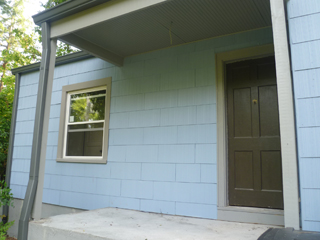 I recently completed a large-scale renovation of this home for an investor. I basically gutted the entire home and started over, at least on the inside. The outside had the older shingle-style siding, probably made from asbestos back when that was thought to be a good idea. Most the shingles were in good shape and didn’t need much except a paint job. However, this corner had a window with lots of troubles!
I recently completed a large-scale renovation of this home for an investor. I basically gutted the entire home and started over, at least on the inside. The outside had the older shingle-style siding, probably made from asbestos back when that was thought to be a good idea. Most the shingles were in good shape and didn’t need much except a paint job. However, this corner had a window with lots of troubles!
At some point the window had been replaced, but the replacement windows were too small. They covered the extra space with some trim boards (that looked awful), and it eventually leaked. The area below the window had obviously been repaired before, though they used lap siding that didn’t match- and it leaked some more! Time to do it right!!
My plan started with removing all the parts that didn’t fit and anything that was damaged. Those old shingles seem to keep the water out okay if they are installed correctly, but they can get brittle and it doesn’t take much to crack or break them. I peeled the layers back until I was down to the framing and started over.
This window was going to be replaced with a new replacement window that actually fit the opening. I just needed to redo the trim which would later be ‘wrapped’ in aluminum by the window contractor to protect it from the elements. Even though it would be covered, I tried to recreate the trim to match the other windows so that it would all be sealed up well and look like the other windows around the house.
Replacing asbestos shingles can be very tricky. I actually had to deal with very few of the old shingles. All the replacement shingles are NON-asbestos. They are manufactured to perfectly match the old ones and they did. The only problem is that they are expensive. (No surprise there!). The fiber cement replacement shingles are from GAF Weatherside and can be purchased directly from them at their website.
INSTALL THE SHINGLES
 To install the fiber cement shingles I used hot-dipped galvanized nails that were left over from installing some beveled wood siding. A small strip of felt paper is installed under the vertical joints of the shingles, overlapping the shingle below. This directs water the gets into the joint down the side of the house and keeps it out.
To install the fiber cement shingles I used hot-dipped galvanized nails that were left over from installing some beveled wood siding. A small strip of felt paper is installed under the vertical joints of the shingles, overlapping the shingle below. This directs water the gets into the joint down the side of the house and keeps it out.
I found it easiest to cut the shingles by laying them on a flat surface at least as large as the shingle so it was well supported. Then I would score them using a backerboard scorring knife (for cutting cementboard for tile installations). It’s got a carbide tipped point that you can use to score the shingle along a straight edge. Score it several times then place a scrap board along the top of the cut where you can apply pressure. Let the scrap piece hang over the edge of your working surface and try to break it off in one piece while the ‘keeper’ section is sandwiched between your boards. Your trying to get a clean cut without braking off too much. Vertical cuts with the textured grooves are pretty easy. It’s the diagonal or horizontal cuts that can be tricky.
IMPORTANT TIP #1: Before you nail your shingle, make sure you first drill a hole through the shingle. Don’t push too hard, let the drill do the work. A masonry bit is probably best because it will dull your others very quickly. Also, don’t nail too close to the edge.
IMPORTANT TIP #2: Plan to break a few! I know they are expensive, but buy some extras. It is very likely that you will break a few in the wrong places when you are installing these.
If you have to cut a notch or hold in your shingle you may be able to try using a jig saw with a carbide-tipped blade (like for cutting tile). This is very difficult to do because the saw my shake the shingle and it will break. Whenever making a cut you want to have the shingle supported well on both sides. They aren’t flexible at all and they will just crack or break and leave you quite frustrated, believe me!
I’ll admit, the window still looks terrible after I got the shingles repaired! It didn’t really improve until the house was painted, the window was replaced and the trim was all wrapped. When it was finished, it was hard to believe it was the same house.
By the way, if you have to replace too many of these shingles you might want to consider just starting over with something else. It may be cheaper and less frustrating!










